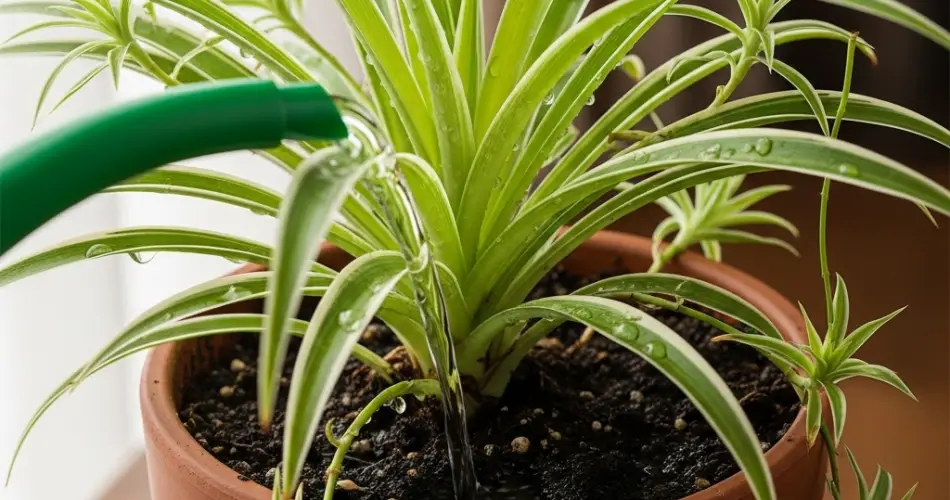Spider plants (Chlorophytum comosum) are among the most forgiving and adaptable houseplants, known for their arching green-and-white leaves and air-purifying qualities. While they’re considered low-maintenance, developing the right watering habits is essential for keeping them healthy, vibrant, and growing strong.
Inconsistent or incorrect watering is one of the most common reasons spider plants develop brown tips, sluggish growth, or root problems. This article breaks down how to water spider plants properly, including how often, how much, and how to recognize signs of over- or underwatering.
Why Spider Plants Are Easy—But Not Indestructible
Spider plants store moisture in their thick roots and rhizomes, which makes them somewhat drought-tolerant. However, they are not succulents. They still need regular watering to thrive, especially during the warmer months or when grown in bright light.
Finding the balance between moist and dry soil is the key to long-term spider plant health.
Ideal Watering Frequency
The best watering schedule depends on your indoor climate, the time of year, and the plant’s environment. Use this general guide as a starting point:
-
Spring and Summer (Active Growth): Water every 7–10 days.
-
Fall and Winter (Dormant Period): Water every 14–21 days.
These timelines can vary depending on humidity levels, temperature, and pot size. The most important rule is: water only when the top inch (2.5 cm) of soil is dry. You can check this easily by inserting your finger into the soil or using a moisture meter.
How to Water Spider Plants Properly
When it’s time to water, make sure you do it thoroughly:
-
Water slowly around the base of the plant until it begins to drain from the bottom.
-
Empty the saucer or tray after 10–15 minutes to avoid root rot.
-
Use room-temperature water to avoid shocking the roots.
Spider plants are especially sensitive to fluoride and chlorine, which are often found in tap water. To prevent leaf tip browning, use filtered water, distilled water, or allow tap water to sit out overnight before using it.
Signs of Overwatering
Overwatering is one of the most common causes of root rot and general plant decline. Spider plants in soggy soil can develop:
-
Yellowing leaves
-
Soft, mushy roots
-
Wilting, even when the soil is wet
-
A sour or musty smell from the pot
If you suspect overwatering, let the soil dry out completely before watering again. You may also need to repot the plant in fresh, well-draining soil if root rot has set in.
Signs of Underwatering
On the flip side, spider plants that go too long without water will show:
-
Dry, crispy leaf tips
-
Curling or drooping leaves
-
Soil pulling away from the sides of the pot
-
Leaf drop or stunted growth
To revive a thirsty spider plant, water it deeply and allow the moisture to reach the roots. If the soil has compacted or become hydrophobic (repelling water), soak the entire pot in a basin of water for 15–20 minutes.
The Best Soil and Pot for Moisture Control
Spider plants thrive in loose, well-draining soil that holds moisture without staying soggy. A standard indoor potting mix blended with a bit of perlite or coarse sand works well.
Choose a pot with proper drainage holes. Plastic, ceramic, or terra cotta pots all work, but terra cotta has the advantage of allowing excess moisture to evaporate through the sides. This helps reduce the risk of root rot in humid environments.
Adjusting Watering by Season and Conditions
Spider plants respond to changes in light, temperature, and humidity. During hot, bright summers, they may need water more frequently. In cooler months or dim indoor spaces, cut back to avoid soggy roots.
If you live in a dry climate or use indoor heating during winter, consider increasing humidity through a pebble tray or occasional misting—but don’t rely on misting alone to meet their moisture needs.
Pro Tips for Healthy Growth
-
Avoid routine watering days. Always check the soil first.
-
Water early in the day so excess moisture evaporates.
-
Flush the soil monthly to remove mineral buildup that can cause browning tips.
-
Watch for baby plantlets. A happy, well-hydrated spider plant will grow “spiderettes” that can be snipped and propagated.
Conclusion
Spider plants don’t demand perfection, but they do appreciate consistent and thoughtful watering. By letting the soil dry slightly between waterings, using quality water, and adjusting for seasonal changes, you can keep your spider plant lush, green, and thriving indoors. With the right habits, your spider plant will reward you with beautiful foliage and plenty of baby plantlets to share.



